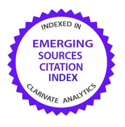Best practice policy on gender equality
Anales del Instituto de Actuarios Españoles is firmly committed, both in its organisation and in its editorial features, to gender policies that lead to real equality between women and men.
Women represent more than 42% of the members of the journal's Editorial Board as well as 62.5% of its review panel.
Use of inclusive language
The journal uses inclusive language in line with the United Nations goal of "expressing oneself orally and in writing without discriminating against a particular sex, social gender or gender identity and without perpetuating gender stereotypes" (https://www.un.org/es/gender-
Full names of the authors, reviewers and Editorial Board
The names of the authors who publish in the journal, of those who are part of the Editorial Board and of the reviewers who participate each year, are always included.
Gender analysis in research
In articles containing representative population samples, authors should indicate whether gender has been considered in the design and development of the research in order to allow for the identification of possible differences and/or to avoid bias.
Reporting sex- and gender-based analyses
There is no single, universally agreed-upon set of guidelines for defining sex and gender. We offer the following guidance:
- Sex and gender-based analyses (SGBA) should be integrated into research design when research involves or pertains to humans, animals or eukaryotic cells and when sex and gender is relevant for the study outcome. This should be done in accordance with any requirements set by funders or sponsors and best practices within a field.
- Sex and/or gender dimensions of the research should be addressed within the article or declared as a limitation to the generalizability of the research.
- Definitions of sex and/or gender applied should be explicitly stated to enhance the precision, rigor and reproducibility of the research and to avoid ambiguity or conflation of terms and the constructs to which they refer.
We advise you to read the Sex and Gender Equity in Research (SAGER) guidelines and the SAGER checklist (PDF) on the EASE website, which offer systematic approaches to the use of sex and gender information in study design, data analysis, outcome reporting and research interpretation.
For further information we suggest reading the rationale behind and recommended use of the SAGER guidelines.
Definitions of sex and/or gender
We ask authors to define how sex and gender have been used in their research and publication. Some guidance:
- Sex generally refers to a set of biological attributes that are associated with physical and physiological features such as chromosomal genotype, hormonal levels, internal and external anatomy. A binary sex categorization (male/female) is usually designated at birth ("sex assigned at birth") and is in most cases based solely on the visible external anatomy of a newborn. In reality, sex categorizations include people who are intersex/have differences of sex development (DSD).
- Gender generally refers to socially constructed roles, behaviors and identities of women, men and gender-diverse people that occur in a historical and cultural context and may vary across societies and over time. Gender influences how people view themselves and each other, how they behave and interact and how power is distributed in society.

















